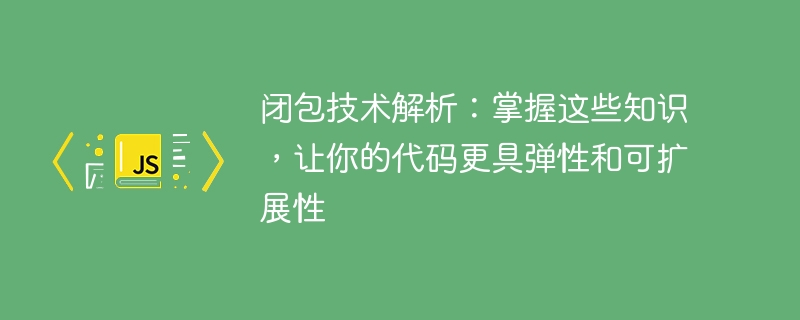

Analysis of closure technology: Master this knowledge to make your code more flexible and scalable. Specific code examples are required
Introduction:
In programming In the world, closure is a very powerful and flexible concept. By using closure techniques, you can make your code more resilient and scalable. This article will delve into what closures are, how they work, and how to apply closure techniques in practice. We will use specific code examples to help readers better understand and apply closures.
Part 1: The Concept and Working Principle of Closure
Closure means that a function can access variables defined in its external function and can continue to use these variables after the execution of its external function ends. In other words, a closure creates an independent environment that contains all the variables in the scope in which the function is defined. These variables are private to the function and cannot be accessed by other functions.
Closures work by binding a function to its environment (that is, the scope in which the function is defined). When a function is called, it creates a new execution context and saves the environment information required by the function. When the function is executed, the execution context will be saved forever. This is how closures are implemented.
Part 2: Application Scenarios of Closures
Closures are widely used in many programming languages. It can be used to implement many useful functions, including but not limited to:
Part 3: Specific code examples
Below we will use some specific code examples to illustrate the application of closures.
function createCounter() {
let count = 0;
return {
increment: function() {
count++;
},
decrement: function() {
count--;
},
getCount: function() {
return count;
}
};
}
let counter = createCounter();
console.log(counter.getCount()); // Output: 0
counter.increment();
console.log(counter.getCount()); // Output: 1function delayExecute(func, delay) {
setTimeout(func, delay);
}
function sayHello() {
console.log("Hello World");
}
delayExecute(sayHello, 3000); // Output after 3 seconds: Hello Worldfunction createButton() {
let count = 0;
let button = document.createElement("button");
button.innerHTML = "Click Me";
button.addEventListener("click", function() {
count++;
console.log("Button was clicked " + count + " times");
});
return button;
}
let myButton = createButton();
document.body.appendChild(myButton);Conclusion:
Closures are a powerful technique that can make your code more resilient and scalable. By using closures, we can achieve functions such as data hiding and encapsulation, delayed execution, and event handling. Mastering the concept and working principle of closures and being good at applying them to actual programming work will improve your code quality and development efficiency. I hope the code examples in this article can help readers better understand and apply closure technology.
The above is the detailed content of An in-depth analysis of closure technology: master these principles to make your code more flexible and scalable. For more information, please follow other related articles on the PHP Chinese website!
 How to set both ends to be aligned in css
How to set both ends to be aligned in css
 telnet command
telnet command
 How to configure maven in idea
How to configure maven in idea
 How to solve dns_probe_possible
How to solve dns_probe_possible
 What are the formal digital currency trading platforms?
What are the formal digital currency trading platforms?
 What does it mean when a message has been sent but rejected by the other party?
What does it mean when a message has been sent but rejected by the other party?
 How to implement jsp paging function
How to implement jsp paging function
 Registration domain name query tool
Registration domain name query tool